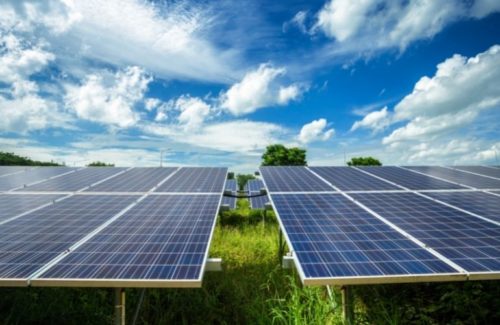Solar policy support is usually led by Democrats, from federal legislators down to local office holders. These lawmakers are driven largely by environmental concerns in their work to create progressive solar policy. But one sector of solar is not only receiving increasing attention from conservative Republicans, it’s being spearheaded by them — especially in the Midwest.
“Community solar seems to be the conservative option to renewables,” said Jim Murray, Midwest regional director for the Coalition for Community Solar Access (CCSA).
In Wisconsin, GOP leaders in the state’s House and Senate introduced a community solar-enabling bill; and in Michigan, a Republican and a Democratic representative, who had never before spoken to each other, joined forces to introduce an enabling bill.
“It’s rare these days to find an issue that is truly bipartisan and is a win-win for everyone,” said Michigan Republican Rep. Michele Hoitenga in a press release. “Community solar is one of those rare issues, and I’m proud to be working across the aisle on this important issue for our residents.”
Community solar aligns with conservative values for a number of reasons. First, it’s available to a large swath of traditionally Republican constituents — including farmers and other rural residents who stand to benefit from leasing their land for community solar projects.
“As conservatives, we believe in property rights and we believe that the government shouldn’t be regulating what can and can’t go on the property that we own,” said Tyler Duvelius, director of external affairs for the nonprofit Conservative Energy Network (CEN). “Solar energy has been a tremendous economic boon for farmers and landowners that get it on their land.”
However, the same “property rights” tenet of conservatism is used against renewables in other Midwest states. Ohio recently passed a bill requiring all future utility-scale solar and wind farms be approved by county commissioners in addition to the state power siting board, which will subject developers to even longer approval timelines and more uncertainty. Although it targets larger utility-scale projects, it shows that same argument can be used against solar power in general just as easily.
When it comes to incentive-driven sectors like rooftop solar, conservatives aren’t shy about their disdain. But community solar’s larger scale means it costs less to build and is also more affordable for subscribers. It’s seen by Republicans as more of a free-market option.
“It’s not intrusive, it’s not a big government mandate and it’s something that they can tangibly see in their own communities,” Duvelius said.
State Sen. Duey Stroebel said he’s sponsoring the Wisconsin community solar bill to diversify the energy options in his state.
“The issues I have with the conventional power industry today is the monopoly that they have and the regulatory environment that they have. I think both of them oftentimes are overdone and really squelch competition, and competition of course creates more reliability, lower costs and it does a better job of meeting consumer demands,” Stroebel said.
He said Wisconsin has some of the highest utility rates in the Midwest and that his constituents are eager for more energy choices beyond the major utilities. He supports community solar as an antidote to that problem because he says it can flourish without government subsidies.
“I want to see these sources of energy stand on their own, and the community solar people have indicated we can stand on our own. We don’t need those subsidies. We’ve got a model that can work by selling subscriptions and really creating competition and undercutting the big guys who have been so locked in for years,” he said.
Stroebel said he initially had Democrats supporting his bill, but the utilities and unions convinced many of those lawmakers to reject it because the bill lacks union labor requirements.
“They got to those Democrat legislators with the line that, ‘This isn’t any good because there will be non-union people that will be running this power generation and they’ll be bringing in out-of-state labor,’ which is all just a bunch of bunk, frankly,” Stroebel said.
His bill also includes verbiage prohibiting subscribers from collecting community solar bill credits that exceed their average annual electric bills, and sets parameters for zoning that could be prohibitive to some projects. Democrats may also be reacting to those stipulations.
With Republican majorities in the Wisconsin House and Senate, Stroebel still thinks there’s a good chance the bill will make it to the governor’s desk.
Consolidating Republican support for community solar doesn’t happen on its own. CCSA and CEN have worked behind the scenes in Wisconsin and Michigan to gather the coalition backing necessary to get legislation introduced.
“What I’ve found in both states is that there were threads of community solar all over the place. There were different organizations that had community solar on their list of things that they would like to accomplish and they’ve never had somebody come in and say, ‘OK, let’s focus on community solar, let’s build a coalition, let’s find good sponsors, let’s get some good language,'” Murray said.
Those groups weren’t your typical left-leaning conservation and renewable organizations. In Michigan, supporters of the bill include the municipal league, conservative energy groups and business councils.
“The coalition of people supporting these bills looks a little different than it maybe has in the past, and so I think that’s getting the attention of Republicans that are like, ‘Our constituents are asking for this. This is something small businesses want, this is something that farmers want, this is something that rural voters want,'” said Matt Hargarten, campaigns director for CCSA.
Along with coalition-building, CCSA and other organizations help legislators write the actual legislation to ensure all the parameters are in place for a successful program.
“There are other states that have developed community solar legislation that didn’t counsel with us, and what ends up happening is you get a program that passes but no one does anything with it because it was confusing,” Hargarten said. “We can come in and counsel the stakeholders on how to do that, how to write that legislation in a way that’s going to actually get the intended outcome.”
Whether these Republican-championed community solar bills pass, they pave the way for a new era where some sectors of renewable energy are not as politically polarizing as they once were.
“If you create this energy in a green manner and environmentally friendly, and be competitive and not have to look to the taxpayers to subsidize that creation of the energy, that’s a win-win for everybody. How can you be against that?” Stroebel said.







“In Wisconsin, GOP leaders in the state’s House and Senate introduced a community solar-enabling bill; and in Michigan, a Republican and a Democratic representative, who had never before spoken to each other, joined forces to introduce an enabling bill.”
This is not about Party, it is about change and it’s nice to see some news that one doesn’t have to be a Party proper to embrace solar PV, wind generation and BESS from the utility level down to the residential level to make this “change” happen.
““As conservatives, we believe in property rights and we believe that the government shouldn’t be regulating what can and can’t go on the property that we own,” said Tyler Duvelius, director of external affairs for the nonprofit Conservative Energy Network (CEN). “Solar energy has been a tremendous economic boon for farmers and landowners that get it on their land.””
The cost of the technology is coming down and there seems to be some ‘entities’ that are moving into the Agricultural business, selling solar PV for “Agrisolar” installations to using solar PV panels on greenhouse buildings like a transparent roof covering for the farm’s seedling operations.
Pundits of community solar PV and even wind generation might be able to get (EPC) over and above the local utility to use their systems for resiliency during storm or grid fail events. What folks seem to be missing is at the residential level a solar PV system with smart energy storage can be set up to be a resiliency system that allows them power to critical house circuits during storm and grid outage events. As more folks buy into the resiliency system or what can be considered a home micro-grid, they are then insolated from the stupidity of the utility, their expectations of the assured operations of a “regulated monopoly” and the cost to residential ratepayers crammed down their throats fees and charges that raise their electricity rates and with operating modes like “standby reserve” may cost more for electricity they may never receive. The big change here will be if and when energy storage battery packs drop in costs at the ‘installed’ level. Right now a lot of home energy storage systems are around $750/kWh installed. One needs to get down to the $350/kWh installed. Folks can then put more solar PV on their roof or ground racking on their property and larger battery pack systems in the 60kWh to 100kWh range and run their homes the majority of the time on solar PV alone. Grid agnostic, it’s a good thing.
““If you create this energy in a green manner and environmentally friendly, and be competitive and not have to look to the taxpayers to subsidize that creation of the energy, that’s a win-win for everybody. How can you be against that?” Stroebel said.””
Subsidized or unsubsidized, I’m pretty sure there’s a lot of taxpayers out there that don’t get back even a small percentage of their tax dollars spent. It will be subsidy free some day, what I focus on is making the laws fair and easy to apply to get one’s own solar PV system with or without energy storage. The incremental increases in capacity of the solar PV panel, the mass manufacturing available to drop prices precipitously over the last 10 years and the promise that soon one will be able to purchase the tri 25 system of panels, batteries and smart inverter/charger warrantee period. This is a legacy system and something every “adult” now should install on their homes to leave a legacy to the next generation that will own that home some day. What cost does one put on Legacy?